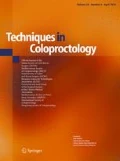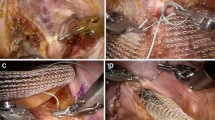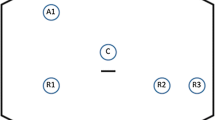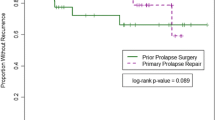Abstract
Background
Laparoscopic resection rectopexy (LRR) and laparoscopic ventral rectopexy (LVR) are favored for the treatment for rectal prolapse (RP) in the USA and Europe, respectively. This study aims to compare these two surgical techniques.
Methods
All patients who underwent LRR because of RP between January 2000 and January 2012 at Cleveland Clinic Florida (Weston, FL, USA) were identified, and all relevant characteristics were entered in a database. This same analysis was also conducted for all patients who underwent LVR in the Meander Medical Center (Amersfoort, the Netherlands) between January 2004 and January 2012. These two cohorts were retrospectively compared with regard to complications, functional results and recurrence.
Results
Twenty-eight patients (all female, mean age 50.1 years) were included in the LRR cohort at a mean follow-up of 57 (range 2–140; standard deviation (SD) ± 41.2) months. The LVR group consisted of 40 patients (36 females and 4 males) with a mean age of 67.0 years and a mean follow-up of 42 (range 2–82; SD ± 23.8) months. A significant reduction in constipation was observed in both cohorts after surgery: 57 versus 21 % after LRR and 55 versus 23 % after LVR (both P < 0.05). The incidence of incontinence also significantly decreased in both groups: 15 % after LVR (55 % before surgery) and 4 % after LRR (61 % before surgery). Direct comparison of these two techniques showed a trend to significance (P = 0.09). Significantly, more complications occurred after LRR (n = 9: 1 major, 8 minor) then after LVR (n = 3: 2 major, 1 minor) (P < 0.05).
Conclusions
Both LVR and LRR are effective for the treatment for RP. Although both techniques offer significant improvements in functional symptoms, continence may be better after LRR. However, LRR also had a higher complication rate then did LVR.
Similar content being viewed by others
References
Matzel KE, Heuer S, Zhang W (2008) Rectalprolapse: abdominal or local approach. Chirurg 79:444–451
Madiba TE, Baig MK, Wexner SD (2005) Surgical management of rectal prolapse. Arch Surg 140:63–73
Wu JS (2009) Rectal prolapse: a historical perspective. Curr Probl Surg 46:602–716
Kuijpers HC (1992) Treatment of complete rectal prolapse: to narrow, to wrap, to suspend, to fix, to encircle, to plicate or to resect? World J Surg 16:826–830
Laubert T, Bader FG, Kleemann M et al (2012) Outcome analysis of elderly patients undergoing laparoscopic resection rectopexy for rectal prolapse. Int J Colorectal Dis 27:789–795
Wijffels N, Cunningham C, Dixon A, Greenslade G, Lindsey I (2001) Laparoscopic ventral rectopexy for external rectal prolapse is safe and effective in the elderly. Does this make perineal procedures obsolete? Colorectal Dis 13:561–566
Clark CE III, Jupiter DC, Thomas JS, Papaconstantinou HT (2012) Rectal prolapse in the elderly: trends in surgical management and outcomes from the american college of surgeons national surgical quality improvement program database. J Am Coll Surg 215:709–714
Magruder JT, Efron JE, Wick EC, Gearhart SL (2013) Laparoscopic rectopexy for rectal prolapse to reduce surgical-site infections and length of stay. World J Surg 37:1110–1114
Cadeddu F, Sileri P, Grande M, De Luca E, Franceschilli L, Milito G (2013) Focus on abdominal rectopexy for full-thickness rectal prolapse: meta-analysis of literature. Tech Coloproctol 16:37–53
Formijne Jonkers HA, Draaisma WA, Wexner SD et al (2013) Evaluation and surgical treatment of rectal prolapse: an international survey. Colorectal Dis 15:115–119
D’Hoore A, Penninckx F (2006) Laparoscopic ventral recto(colpo)pexy for rectal prolapse: surgical technique and outcome for 109 patients. Surg Endosc 20:1919–1923
Dindo D, Demartines N, Clavien PA (2004) Classification of surgical complications: a new proposal with evaluation in a cohort of 6,336 patients and results of a survey. Ann Surg 240:205–213
Ashari LH, Lumley JW, Stevenson AR, Stitz RW (2005) Laparoscopically-assisted resection rectopexy for rectal prolapse: ten years’ experience. Dis Colon Rectum 48:982–987
D’Hoore A, Cadoni R, Penninckx F (2004) Long-term outcome of laparoscopic ventral rectopexy for total rectal prolapse. Br J Surg 91:1500–1505
Stevenson AR, Stitz RW, Lumley JW (1998) Laparoscopic-assisted resection-rectopexy for rectal prolapse: early and medium follow-up. Dis Colon Rectum 41:46–54
Maggiori L, Bretagnol F, Ferron M, Panis Y (2013) Laparoscopic ventral rectopexy: a prospective long-term evaluation of functional results and quality of life. Tech Coloproctol 17:431–436
Boons P, Collinson R, Cunningham C, Lindsey I (2010) Laparoscopic ventral rectopexy for external rectal prolapse improves constipation and avoids de novo constipation. Colorectal Dis 12:526–532
Laubert T, Kleemann M, Schorcht A et al (2010) Laparoscopic resection rectopexy for rectal prolapse: a single-center study during 16 years. Surg Endosc 24:2401–2406
Draaisma WA, van Eijck MM, Vos J, Consten EC (2011) Lumbar discitis after laparoscopic ventral rectopexy for rectal prolapse. Int J Colorectal Dis 26:255–256
Senapati A, Gray RG, Middleton LJ et al (2013) PROSPER: a randomised comparison of surgical treatments for rectal prolapse. Colorectal Dis 15:858–868
Wijffels N, Cunningham C, Dixon A et al (2011) Laparoscopic ventral rectopexy for external rectal prolapse is safe and effective in the elderly. Does this make perineal procedures obsolete? Colorectal Dis 13:561–566
Conflict of interest
None.
Author information
Authors and Affiliations
Corresponding author
Rights and permissions
About this article
Cite this article
Formijne Jonkers, H.A., Maya, A., Draaisma, W.A. et al. Laparoscopic resection rectopexy versus laparoscopic ventral rectopexy for complete rectal prolapse. Tech Coloproctol 18, 641–646 (2014). https://doi.org/10.1007/s10151-014-1122-3
Received:
Accepted:
Published:
Issue Date:
DOI: https://doi.org/10.1007/s10151-014-1122-3




